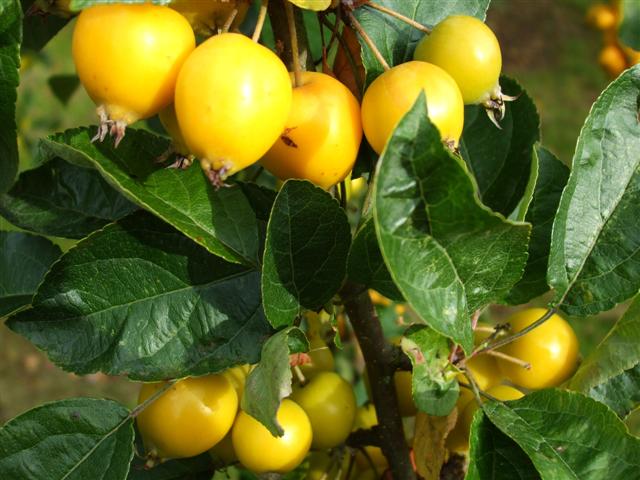Timberpedia - Japanese Crab Apple
Japanese Crab Apple
| Latin Name: | Irish Name: | Native to Ireland? |
|---|---|---|
| Malus floribunda | No |
About the Tree
- Japanese crabapple is an old favorite which produces one of the best flowering displays in midspring of any of the crabapples.
- A dense, broad-spreading, deciduous tree which typically grows 15-25′ tall and to 18-30′ wide. Red buds open in spring to fragrant, pale pink flowers (1.25″ diameter) which mature to white. Flowers are followed by small, yellowish crabapples (to 1/2″ diameter) with a red blush.
- Flowers and subsequent crabapples are very profuse (floribunda meaning “abundant flowers” in Latin), but the fruits are not particularly showy (colorful) by crabapple standards, and usually do not persist beyond fall. Fruits are quite attractive to birds, however.
- Slender ovate, serrate, dark green leaves.
- Moderate disease resistance. Susceptible to apple scab, leaf spot, powdery mildew and fire blight.
- Potential insect pests are of lesser concern
About the Wood
(The following notes apply to Crab Apple itself – an indigenous species. The timber from Japanese Crab Apple is likely to be very similar.)
Hard close grained wood.
Uses of Wood
Wood carving, inlay work, mallets, screws. Good firewood with pleasant aroma. Apple wood has a reddish gray heartwood and light reddish sapwood (12 to 30 rings of sapwood). When steamed, the wood becomes reddish brown to dark red-brown. The wood of wild apple trees is said to be better than that of cultivated varieties, which is also true of pear trees.
Working Properties: The wood, which is very difficult to split, is hard and difficult to work, but is easily stained and polished. The timber converts cleanly but is moderately hard to saw. A clean finish is produced normally, but a reduction of the cutting angle to 20° is an advantage to planing.
Uses: Apple is used in furniture, turnings, mallet heads, skittle balls, umbrella handles, machines and toys, cog wheels, fruit presses, shuttles, wood screws, plane blocks, bookbinder screws, boat knees, canes and walking sticks, drawing instruments, pianos and tool handles.
Know your wood! The Timberpedia is a broad resource that aims to catalogue all the major tree species in Ireland, containing information that we’ve gathered from over two decades maintaining our natural woodland and serving Ireland’s woodworking industry.
All written material is copyright © 2021 by the Lisnavagh Timber Project.
Timberpedia
- Acacia
- Alder (Common)
- Apple
- Apple (Crab)
- Apple (Japanese Crab)
- Ash
- Aspen (Trembling Poplar)
- Beech
- Beech (Copper)
- Beech (Southern)
- Birch
- Box
- Cedar (Western Red)
- Cedar of Lebanon
- Cherry (Bird)
- Cherry (Wild) / Gean
- Chestnut (Horse)
- Chestnut (Sweet / Spanish)
- Cypress (Lawson)
- Cypress (Monterey)
- Elm (English)
- Elm (Wych)
- Eucalyptus
- Fir (Douglas)
- Fir (Grand/Giant)
- Fir (Noble)
- Fir (Silver/European)
- Hawthorn
- Hazel
- Holly
- Hornbeam
- Ivy
- Laburnum
- Larch (European)
- Larch (Japanese)
- Larch (Red)
- Laurel
- Lime
- Maidenhair Tree
- Maple (Field)
- Maple (Norway)
- Mimosa / Silver Wattle
- Monkey-Puzzle
- Musk (Olearia)
- Oak (Cork)
- Oak (Holm / Holly / Evergreen)
- Oak (Pedunculate / English)
- Oak (Red)
- Oak (Sessile / Irish)
- Oak (Turkey)
- Pear
- Pine
- Pine (Scots)
- Plane (London / Lacewood)
- Poplar (Black Cottonwood / Western Balsam)
- Poplar (Grey)
- Rowan (Mountain Ash)
- Spruce (Norway)
- Spruce (Sitka)
- Sycamore
- Tulip Tree
- Walnut (Black)
- Walnut (Common)
- Wellingtonia
- Western Hemlock
- Whitebeam
- Wild Service Tree
- Willow
- Willow (Bay)
- Willow (Crack)
- Willow (Cricket Bat)
- Willow (Goat / Sallow)
- Willow (White / Silver)
- Yew (English)
- Yew (Irish)




